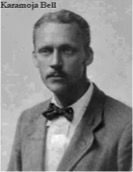Ivory Poaching in the Lado Enclave
Africans and Arabs were not the only ivory poachers in early East Africa. European hunters probably poached far more ivory than Africans and Arabs. Their favoured hunting ground was the Lado enclave, a triangle of land bordering north-west Uganda, Sudan, and the Belgian Congo in 1900. This was ideal elephant country, with heavily wooded hills and valleys, streams, and lush vegetation. Until 1910 the area was administered very slackly by the Belgians in the Congo. Anyone in Uganda could cross the Nile, maintain a day’s march between him and the nearest Congolese administrative post, shoot as many elephants as he could, and transport the tusks back across the Nile to Uganda.

Map showing the Lado Enclave
W D M ‘Karamoja’ Bell, it is said, once returned to Uganda with 349 pairs of tusks. Things got even worse when an Italian named Giusto Berti, the enterprising proprietor of the Equatorial Hotel in Entebbe, spotted a commercial opening. In 1908 he set himself up in Wadelai where he welcomed European adventurers. He supplied them with arms and ammunition and stores in return for half their ivory, and showed them how to cross the Nile into the Lado enclave. Belgian officials turned a blind eye or were bribed to ignore the trade, and very early British Ugandan officials did not seem to mind about it, while the local Africans in the enclave displayed no opposition in return for free elephant meat. In 1911 Berti shipped 9,000 pounds of ivory to Europe.

Karamoja Bell
The poachers often crossed the Nile at Butiaba, assisted by Charles Bennett of the Uganda Marine, who ran the steamer Kenia. After they returned to Uganda with tusks, they had no difficulty disposing of them. Both Allidina Visram, a merchant with shops in Kampala, Masindi, Koba and Nimule, and Kengi Bange, another trader, would purchase male ivory. Male ivory was of two types – green, or dead. Green was ivory from freshly killed elephants, while dead ivory was tusks that had been buried after elephants had been killed some time ago. Africans who killed elephants would often bury the tusks until they had a chance to sell them to incoming poachers. The two types of ivory attracted very different taxes in Uganda. Green ivory was taxed at 10% on import, and 15% on export from Uganda, while dead ivory had only a nominal tax. Ivory from female elephants, distinguishable by its close grain, was forbidden and confiscated if detected. Arabs sold female ivory in Abyssinia, a country devoid of restrictions. With such exorbitant taxation, strenuous were the efforts to bamboozle the authorities. Fresh ivory was buried in elephant dung, to ‘age’ it.
The slaughter of elephants in the Lado enclave reached massive proportions in the first decade of the 20th century. In 1910 the British gained control of the area from the Belgians, placing it under their authorities in Sudan, which they administered at that point. They made efforts to stop the trade, but they were woefully understaffed and could not really engage in lengthy pursuit of poachers. There was some success, however. The two notorious poachers Glencross and J H Caink were arrested by the official C H Stigand, though this may have been because, apart from poaching, they burned an Indian trader’s store and cut the telephone line. Then there was the famous pursuit by Charles Vincent Fox and shooting of James Wood Rogers, which I detailed in my blog of April 2021. Tales of these successes did not deter the poachers – on the contrary, poaching increased. What put a stop to it was war – the First World War, which denuded the civilian ranks of potential poachers, whose fire was now directed at Germans rather than elephants. An adjustment of boundaries caused the southern Lado enclave to be given to Uganda and the British gradually established firm control there, with regular patrols almost eliminating poaching by white hunters.
http://www.europeansineastafrica.co.uk

Recent Comments